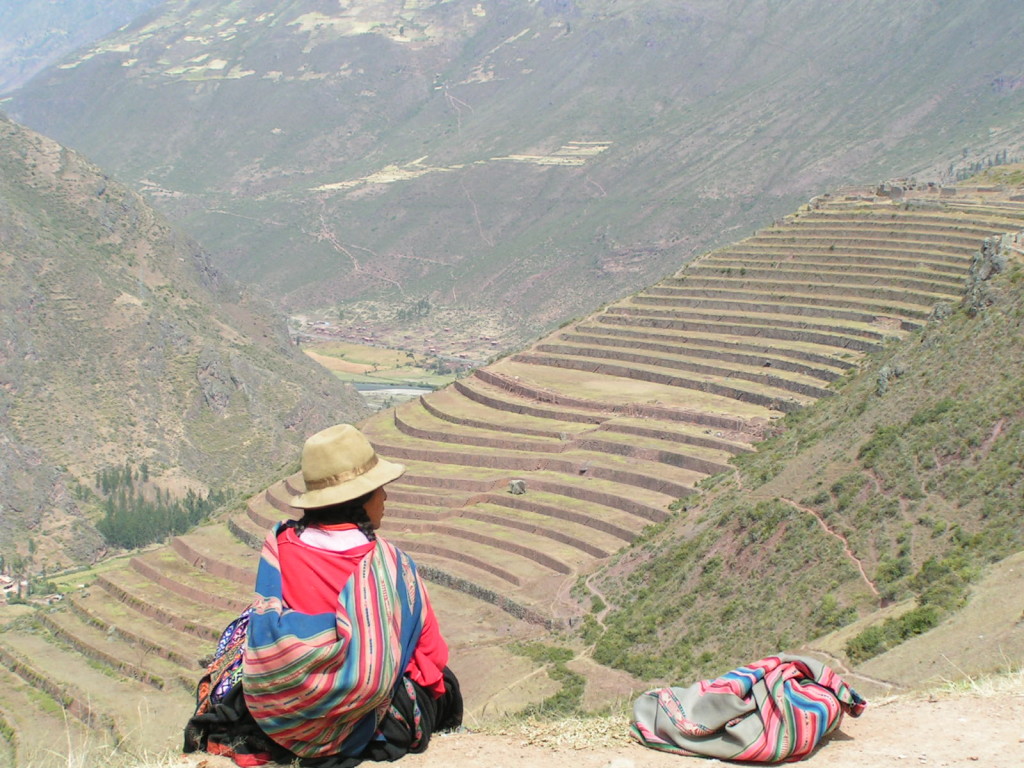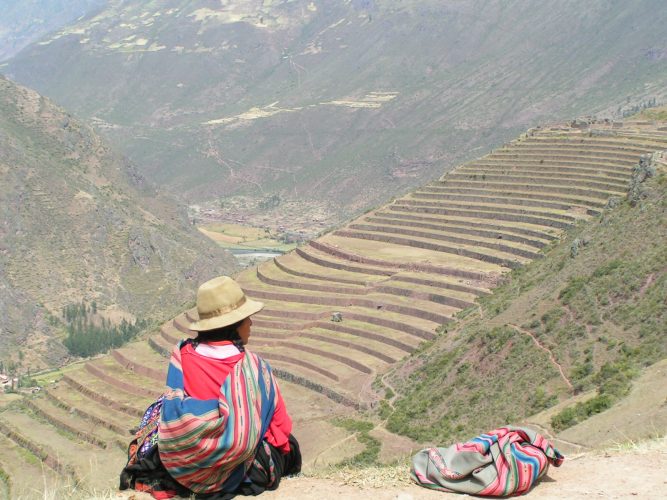 The vast mountainous region in central Peru is distinctly calm except for the bustling city of Huaraz (3100 meters). Foreigners swarm to the city for its proximity to the Cordillera Blanca, the world’s highest tropical region mountain range that offers amazing vistas alongside beautiful pristine lakes. Before leaving to explore, the tourists pick up maps, gear, and bicycles with which to embark; seeing as there are an endless array of shops with the same services promoting the exquisite wilderness and their pride for region and country. The real struggle is speaking and ordering in Spanish, for English is not widely known in those parts. Even “La Policia Turistica” who must respond to all complaints of faulty rental equipment for example, relies on your knowledge of the Castilian language. After pronouncing the widely used form of hello in Peru, “Buen Día” (instead of “Buenos Dias”) and having a “mate de coca”, which helps you support the high altitudes, you can take a “colectivo” (van) to climb the first 500 meters towards your final destination. Taxis will offer you a better price (less than 10 soles per person) but will take you on the bumpiest ride; you would never believe the vehicle had a life afterwards. Stepping out at 3600 meters altitude you are surrounded by huts and farm animals lining the road. In this area, your Spanish is comprehensible enough to spend money on a bottle of water or “gaseosa” (soda) that the children plead from you, and maybe ask when the last “colectivo” evacuates the tourists at night, but other conversation is asking too much.
The vast mountainous region in central Peru is distinctly calm except for the bustling city of Huaraz (3100 meters). Foreigners swarm to the city for its proximity to the Cordillera Blanca, the world’s highest tropical region mountain range that offers amazing vistas alongside beautiful pristine lakes. Before leaving to explore, the tourists pick up maps, gear, and bicycles with which to embark; seeing as there are an endless array of shops with the same services promoting the exquisite wilderness and their pride for region and country. The real struggle is speaking and ordering in Spanish, for English is not widely known in those parts. Even “La Policia Turistica” who must respond to all complaints of faulty rental equipment for example, relies on your knowledge of the Castilian language. After pronouncing the widely used form of hello in Peru, “Buen Día” (instead of “Buenos Dias”) and having a “mate de coca”, which helps you support the high altitudes, you can take a “colectivo” (van) to climb the first 500 meters towards your final destination. Taxis will offer you a better price (less than 10 soles per person) but will take you on the bumpiest ride; you would never believe the vehicle had a life afterwards. Stepping out at 3600 meters altitude you are surrounded by huts and farm animals lining the road. In this area, your Spanish is comprehensible enough to spend money on a bottle of water or “gaseosa” (soda) that the children plead from you, and maybe ask when the last “colectivo” evacuates the tourists at night, but other conversation is asking too much.
Well, at least you can conserve your breath, as oxygen becomes scarce; and the arduous hike has only just commenced. The path offers amazing colors, crimson yellow grasses, blue skies, and brown animals dotting the hillside. Only you realize soon enough that the maps at the tourist shops in Huaraz where more promotional than technical. The scale is such that many a fork in the road is not depicted, and a few wrong turns have you completely lost. At 3800 meters there are no huts and only a few journeying women with large bundles on their backs, or a few old men with herds of cows. They do not respond to Spanish, but speak a rather incomprehensible language. This is Quechua, an indigenous language spoken just beyond the limits of civilization. In Huaraz these limits are around the 4,000 meter mark. Elsewhere, the rural countryside probably boasts larger numbers of these native people. Overall, Peru has the highest number of Quechua speakers in the Andean region and the second highest number of Aymara speakers (another indigenous language) behind Bolivia. These means of communication are pre-Incan and far from extinct today, a source of marvel for modern-day linguists. This is despite severe regresses in the number of Quechua speakers throughout the last century, partly from mass-murdering of indigenous people conducted by the Sendero Luminoso.
Quechua is a language family that is comprised of several dozen dialects (some very distinct) that were once largely united under the Incan Empire. Formerly called the runa simi, to designate the language of the populace, an alphabet was only introduced much later by Spanish missionaries. The structure of the language includes a significant amount of suffixes that combine with complicated conjugations to create for elongated words. Rather than delve into all the particularities Quechua presents, it is interesting to note some modern words that have Quechua origins. “Papa” in Spanish for potato comes from Quechua while English was able to retrieve words such as “condor” and “coca”, decidedly naturalistic. Remarkable is “mamá” which has obvious Indo-European roots, but is also found in pre-Columbian Quechua dialogue. While less astounding, “Chhikan” in Quechua is a word for “size”, similar to the Greek word for gigantic. However such an ancient language can barely be guessed from a repertory of Modern ones, and is much less pronounceable due to the different sounds for “q”, “k”, and “ch”. For the lucky hiker in the Andes (or unlucky), the Quechua speaker may not understand your plea for directions. However, it is an acceptable fate to get lost a few hours in this magnificent Peruvian wilderness. The mountains and streams speak to you in a much more understandable way. Maybe the indigenous people derived their rather mystical languages from what they themselves could hear? In any case Spanish is probably more important for visits to Peru.
For an overview of our translation expertise, visit our media and marketing translation page




